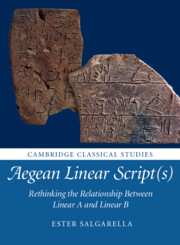
-
Select format
-
- Publisher:
- Cambridge University Press
- Publication date:
- September 2020
- October 2020
- ISBN:
- 9781108783477
- 9781108479387
- 9781108742672
- Dimensions:
- (276 x 219 mm)
- Weight & Pages:
- 1.37kg, 436 Pages
- Dimensions:
- (276 x 203 mm)
- Weight & Pages:
- 1.04kg, 438 Pages
You may already have access via personal or institutional login
Book description
When does a continuum become a divide? This book investigates the genetic relationship between Linear A and Linear B, two Bronze Age scripts attested on Crete and Mainland Greece and understood to have developed one out of the other. By using an interdisciplinary methodology, this research integrates linguistic, epigraphic, palaeographic and archaeological evidence, and places the writing practice in its sociohistorical setting. By challenging traditional views, this work calls into question widespread assumptions and interpretative schemes on the relationship between these two scripts, and opens up new perspectives on the ideology associated with the retention, adaptation and transmission of a script, and how identity was negotiated at a moment of closer societal interaction between Cretans and Greek-speaking Mainlanders in the Late Bronze Age. By delving deeper into the structure and inner workings of these two writing systems, this book will make us rethink the relationship between Linear A and B.
Contents
Metrics
Altmetric attention score
Full text views
Full text views help Loading metrics...
Loading metrics...
* Views captured on Cambridge Core between #date#. This data will be updated every 24 hours.
Usage data cannot currently be displayed.
Accessibility standard: Unknown
Why this information is here
This section outlines the accessibility features of this content - including support for screen readers, full keyboard navigation and high-contrast display options. This may not be relevant for you.
Accessibility Information
Accessibility compliance for the PDF of this book is currently unknown and may be updated in the future.


